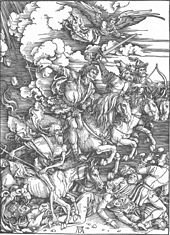Nativity Rider
Krippenreiter is an early New High German ridiculous name for members of the nobility who, due to personal impoverishment or addiction to advantage, lead a life as wandering guests “riding from manger to manger” with neighbors, relatives or strangers and at the expense of their hosts to get the comforts of a befitting life search.
history
The term is occupied first in the 17th century in Silesia and stood there in the context of social tensions between the long-established, primarily on the agricultural produce of his estates instructed hereditary nobility and the Ascended by services and urban commercial and financial transactions letter Adel , whose members in turn as " Pepper Sacks ”were ridiculed. Jakob Schickfuß (1625) referred to as "Krippenreuter / Stäncker / vnd Knoblochsgäste" (1625) parasites who take advantage of the traditionally generous hospitality of both aristocratic groups, while Paul Winckler (around 1680) as "Krippen-Reuter" primarily referred to decrepit members of the old landed gentry describes who not only plague their nouveau riche hosts as pleasure and trade addicted permanent guests with outrageous aspirations, but also cheat and steal from them and reward resistance with violence and arson. Ahasverus Fritsch , who uses the term “Wurstreiter” instead of “Krippenreiter” (“Appellantur tales alicubi Wurstreutter / because they regret and feed on the sausage from one place to another”), reports on Thuringia and Saxony that the nuisance and economic burden of the Adels reached such an extent through neighborly visits that it had to be limited by sovereign ordinances: according to a Gotha police order cited by him , friendship visits were permitted "with good order and modesty", while it was a punishable offense to host the host "with excessive servants / or appendix ”to complain“ to stay with him day and night ”“ with honeymoon words / snore [d. H. Threaten] / throb or in some other way “to demand more than what is well and voluntarily granted.
Crib rider as a literary motif
The crib riders experienced an edifying interpretation through the epitome Krippen-Reuter by Friedrich von Logau (1654), according to which such "Volck" with his "Wercken" refers people to the fact that they are not "at home" in this earthly world, but only on the Passing through to a better world in the hereafter is:
"IT is a people that binds their horse to a foreign manger /
That warms itself by another fire / finds
another plate: Don't spoil them! it is the people / that shows us in the Wercke /
how that man is not at home here / and just travels through here "
The crib rider appears in Matthias Abele von und zu Lilienberg's (1675) with religiously grounded, but concetto- like capricious metaphors when he refers to the death of “ such a emaciated crib Reuter ”, “ this Schind or crib Reuter “, Speaks: as tertium comparationis , the emaciated appearance of the actual 'crib rider', possibly caused by poverty, is transferred to the personification of death, as it is in the tradition of the John's apocalypse in connection with its statements about the fourth apocalyptic rider ( Rev 6 : 8 LU ) was presented as an emaciated old man or the Grim Reaper on a "pale" horse.
More recently, the German-Baltic writer Eva von Radecki has drawn the portrait of an elderly Courland nobleman (Gert von Haldring) in the late 17th century in the melancholy and humorous novella Der Krippenreiter (1907, first edition 1916) , who after losing his goods Accompanied for two decades by his only servant (Krams) as a stray guest at the courts of his wealthy relatives and peers, he has been eking out his existence, remotely based on Don Quixote , under the imagined and actual humiliations and insults that happen to him from his surroundings, tries to uphold his ideals of honor and chivalry.
Individual evidence
- ↑ Manger rider. In: Jacob Grimm , Wilhelm Grimm (Hrsg.): German dictionary . tape 11 : K - (V). S. Hirzel, Leipzig 1873 ( woerterbuchnetz.de ).
- ↑ Jakob Schickfuß : New increased Schlesische Chronica . Zacharias Schürer, Breslau undated [1625], p. 39 f.
- ^ Paul Winckler: Der Edelmann Christoph Riegel, Nuremberg 1697 (facsimile ed. By Lynne Tatlock, Bern [among others]: Lang, 1988), reproduced in excerpts and commented on by Gustav Freytag . New pictures from the life of the German people . Hirzel, Leipzig, 1863, pp. 75 ff. Before that: Images from the German past. Pepper sacks and crib riders around 1660 . In: Die Grenzbote , year 19, 2nd half of the year, volume 3, 1860, p. 1 ff.
- ↑ Ahasverus Fritsch: Nobilis peccans, sive tractatus de peccatis nobilium . Wolfgang Moritz Endter, Nuremberg 1685, p. 32 f. (Conclusion VII)
- ^ Matthias Abele von und zu Lilienberg, Vivat or so-called artificial disorder , part 5, Nuremberg: Michael and Johann Friede, 1675, p. 207
- ^ Eva von Radecki: The crib rider . In: Hellmuth Krüger (ed.): The Baltic Provinces . Volume 2: Novels and Dramas . Felix Lehmann, Berlin 1916, pp. 77–119.
